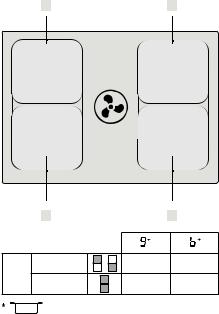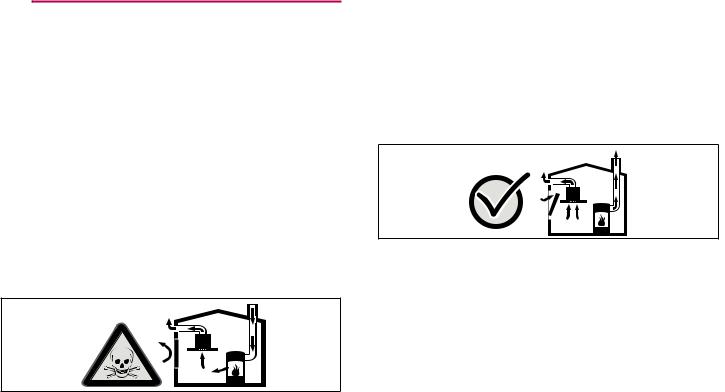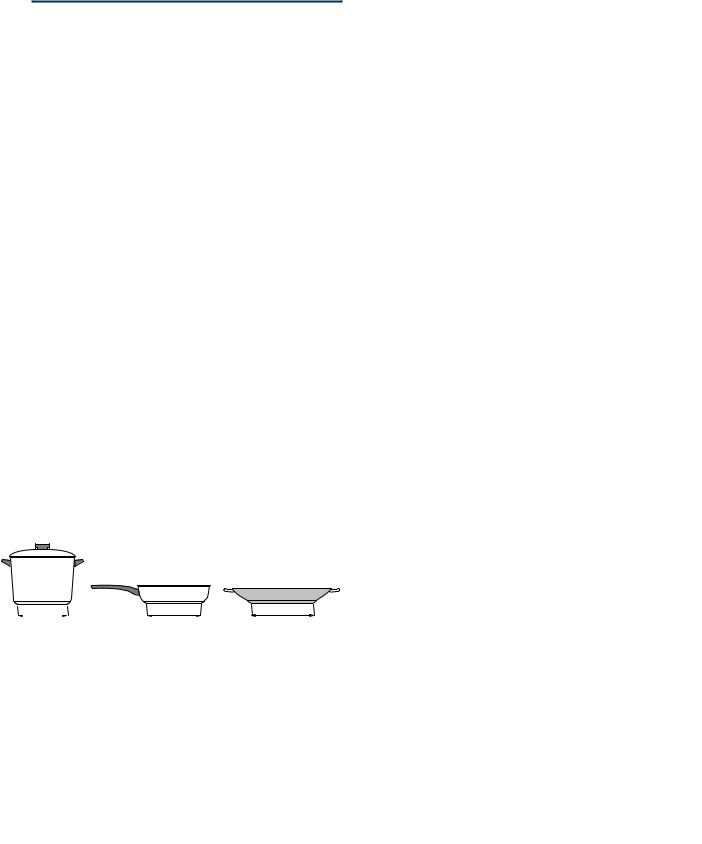Bosch PVQ731F15E, PVQ711F15E, PVQ811F15E Instructions for Use

3FHJTUFS ZPVS . OFXEFWJDFPO Z#PTDIOPXBOE HFUGSFFCFOFGJUT CPTDI IPNF DPN XFMDPNF
Induction hob with integrated ventilation system
PVQ...F1..
[en] Instruction manual |
Hob |

 :
: 
|
|
|
|
|
: : |
|
[ |
: |
|
,(& |
|
2 |
Ø = cm |

Table of contents
8Intended use . . . . . . . . . . . . . . . . . . . . . . . . . . . . . 4
(Important safety information . . . . . . . . . . . . . . . 5
]Causes of damage . . . . . . . . . . . . . . . . . . . . . . . . 7
7Environmental protection . . . . . . . . . . . . . . . . . . 7
Energy saving tips . . . . . . . . . . . . . . . . . . . . . . . . . . . . 7 Environmentally-friendly disposal . . . . . . . . . . . . . . . . . 7
fInduction cooking . . . . . . . . . . . . . . . . . . . . . . . . 8
Advantages of induction cooking. . . . . . . . . . . . . . . . . 8 Cookware. . . . . . . . . . . . . . . . . . . . . . . . . . . . . . . . . . . 8
*Getting to know your appliance . . . . . . . . . . . . . 9
Your new appliance . . . . . . . . . . . . . . . . . . . . . . . . . . . 9 Special accessories . . . . . . . . . . . . . . . . . . . . . . . . . . . 9 The control panel . . . . . . . . . . . . . . . . . . . . . . . . . . . . 10 The hotplates . . . . . . . . . . . . . . . . . . . . . . . . . . . . . . . 11 Residual heat indicator. . . . . . . . . . . . . . . . . . . . . . . . 11
ÇOperating modes . . . . . . . . . . . . . . . . . . . . . . . . 12
Exhaust air mode . . . . . . . . . . . . . . . . . . . . . . . . . . . . 12 Circulating-air mode . . . . . . . . . . . . . . . . . . . . . . . . . . 12
KBefore using for the first time. . . . . . . . . . . . . . 12
Setting the operating mode . . . . . . . . . . . . . . . . . . . . 12
1Operating the appliance . . . . . . . . . . . . . . . . . . 13
Switching the hob on and off . . . . . . . . . . . . . . . . . . . 13 Setting a hotplate . . . . . . . . . . . . . . . . . . . . . . . . . . . . 13 Chef's recommendations . . . . . . . . . . . . . . . . . . . . . . 14 Manual hood control . . . . . . . . . . . . . . . . . . . . . . . . . 16 Intensive setting . . . . . . . . . . . . . . . . . . . . . . . . . . . . . 16 Automatic start . . . . . . . . . . . . . . . . . . . . . . . . . . . . . . 16 Run-on function . . . . . . . . . . . . . . . . . . . . . . . . . . . . . 16
wCombiZone function . . . . . . . . . . . . . . . . . . . . . 17
Notes regarding cookware. . . . . . . . . . . . . . . . . . . . . 17 Activation . . . . . . . . . . . . . . . . . . . . . . . . . . . . . . . . . . 17 Deactivating . . . . . . . . . . . . . . . . . . . . . . . . . . . . . . . . 17
uMove function. . . . . . . . . . . . . . . . . . . . . . . . . . . 17
Advice on using cookware. . . . . . . . . . . . . . . . . . . . . 17 Activation . . . . . . . . . . . . . . . . . . . . . . . . . . . . . . . . . . 18 Deactivation . . . . . . . . . . . . . . . . . . . . . . . . . . . . . . . . 18
OTime-setting options . . . . . . . . . . . . . . . . . . . . . 18
Programming the cooking time . . . . . . . . . . . . . . . . . 18 The kitchen timer . . . . . . . . . . . . . . . . . . . . . . . . . . . . 19
en
vPowerBoost function . . . . . . . . . . . . . . . . . . . . . 19
Activating . . . . . . . . . . . . . . . . . . . . . . . . . . . . . . . . . .19 Deactivation . . . . . . . . . . . . . . . . . . . . . . . . . . . . . . . .19
AChildproof lock. . . . . . . . . . . . . . . . . . . . . . . . . . 20
Activating and deactivating the childproof lock . . . . .20 Childproof lock . . . . . . . . . . . . . . . . . . . . . . . . . . . . . .20
kWipe protection . . . . . . . . . . . . . . . . . . . . . . . . . 20
bAutomatic safety cut-out . . . . . . . . . . . . . . . . . . 20
QBasic settings. . . . . . . . . . . . . . . . . . . . . . . . . . . 21
To access the basic settings: . . . . . . . . . . . . . . . . . . .22
[Energy consumption indicator . . . . . . . . . . . . . 23
tCookware check. . . . . . . . . . . . . . . . . . . . . . . . . 23
hPower manager . . . . . . . . . . . . . . . . . . . . . . . . . 24
DCleaning . . . . . . . . . . . . . . . . . . . . . . . . . . . . . . . 24
Cleaning agents . . . . . . . . . . . . . . . . . . . . . . . . . . . . .24 Components to clean . . . . . . . . . . . . . . . . . . . . . . . . .25
Hob surround (only on appliances with hob surrounds). 25
Hob . . . . . . . . . . . . . . . . . . . . . . . . . . . . . . . . . . . . .25 Ventilation system. . . . . . . . . . . . . . . . . . . . . . . . . . . .26 Cleaning the overflow container . . . . . . . . . . . . . . . . .27
{Frequently Asked Questions (FAQ) . . . . . . . . . 28
3Trouble shooting . . . . . . . . . . . . . . . . . . . . . . . . 30
4Customer service . . . . . . . . . . . . . . . . . . . . . . . . 31
Product number (E no.) and production number (FD |
|
no.) . . . . . . . . . . . . . . . . . . . . . . . . . . . . . . . . . . . . . |
31 |
ETest dishes . . . . . . . . . . . . . . . . . . . . . . . . . . . . . 32
Additional information on products, accessories, replacement parts and services can be found at www.bosch-home.com and in the online shop www.bosch-eshop.com
3

en Intended use
8Intended use
Read these instructions carefully. Please keep the instruction and installation manual, as well as the appliance certificate, in a safe place for later use or for subsequent owners.
Check the appliance after removing it from the packaging. If it has suffered any damage in transport, do not connect the appliance, contact the Technical Assistance Service and provide written notification of the damage caused, otherwise you will lose your right to any type of compensation.
Only a licensed professional may connect appliances without plugs. Damage caused by incorrect connection is not covered under warranty.
This appliance must be installed according to the installation instructions included.
This appliance is intended for private domestic use and the household environment only. The appliance must only be used for the preparation of food and beverages. The cooking process must be supervised. A short cooking process must be supervised without interruption. Only use the appliance in enclosed spaces.
This appliance is intended for use up to a maximum height of 2000 metres above sea level.
Do not use covers. These can cause accidents, for example due to overheating, catching fire or materials shattering.
Only use safety devices or child protection grilles approved by ourselves. Unsuitable safety devices or child protection grilles may result in accidents.
This appliance is not intended for operation with an external clock timer or a remote control.
Dangerous or explosive materials and vapours must not be extracted.
Ensure that no small parts or liquids get into the appliance.
This appliance may be used by children over the age of 8 years old and by persons with reduced physical, sensory or mental capabilities or by persons with a lack of experience or knowledge if they are supervised or are instructed by a person responsible for their safety how to use the
appliance safely and have understood the associated hazards.
Children must not play with, on, or around the appliance. Children must not clean the appliance or carry out general maintenance unless they are at least 15 years old and are being supervised.
Keep children below the age of 8 years old at a safe distance from the appliance and power cable.
If you wear an active implantable medical device (e.g. a pacemaker or defibrillator), check with your doctor that it complies with Council Directive 90/385/EEC of 20th June 1990, DIN EN 45502-2-1 and DIN EN 45502- 2-2, and that it has been chosen, implanted and programmed in accordance with VDE-AR- E 2750-10. If these conditions are satisfied, and if, in addition, non-metal cooking utensils and cookware with non-metal handles are used, it is safe to use this induction hob as intended.
4

(Important safety information
:Warning – Danger of suffocation!
Packaging material is dangerous to children. Never allow children to play with packaging material.
:Warning – Danger of death!
Risk of poisoning from flue gases being drawn back in.
Always ensure that there is an adequate supply of fresh air to the room if the appliance is being operated in air extraction mode at the same time as a non-room-sealed heating appliance is being operated.
Non-room-sealed heating appliances (e.g. gas-, oil-, woodor coal-burning heaters, continuous flow heaters or water heaters) draw in combustion air from the room in which they are installed and discharge the exhaust gases outdoors through an exhaust gas system (e.g. a chimney).
With the extractor hood switched on, air is extracted from the kitchen and the adjacent rooms – without an adequate supply of air, the air pressure falls below atmospheric pressure. Toxic gases from the chimney or the extraction shaft are sucked backed into the living space.
■There must therefore always be an adequate supply of air.
■A supply-air/air-extraction duct alone is not
sufficient to ensure compliance with the limit.
It is only possible to safely operate the appliance if the pressure in the room in which the heating appliance is installed does not drop more than 4 Pa (0.04 mbar) below atmospheric pressure. This can be achieved if the air needed for combustion is able to enter through openings that cannot be sealed, for example through doors, windows, by means of a supply-air/air-extraction duct or by other technical means.
Important safety information |
en |
The exhaust air must not be conveyed into a functioning smoke or exhaust gas flue or into a shaft that is used to ventilate rooms in which heating appliances are installed.
If the exhaust air is to be conveyed into a nonfunctioning smoke or exhaust gas flue, you must obtain the consent of the heating engineer responsible.
Always consult the heating engineer responsible. They will be able to assess the house's entire ventilation setup and suggest the most appropriate ventilation measures. Unrestricted operation is possible if the extractor hood is operated exclusively in air recirculation mode.
:Warning – Risk of fire!
■Hot oil and fat can ignite very quickly. Never leave hot fat or oil unattended. Never use water to put out burning oil or fat. Switch off the hotplate. Extinguish flames carefully using a lid, fire blanket or something similar.
■The hotplates become very hot. Never place combustible items on the hob. Never place objects on the hob.
■The appliance gets hot. Do not keep combustible objects or aerosol cans in drawers directly underneath the hob.
■The hob switches off automatically and can no longer be operated. It may switch on unintentionally at a later point. Switch off the circuit breaker in the fuse box. Contact the after-sales service.
■Fatty deposits in the grease filter may catch fire. Regularly clean the grease filter. Never operate the appliance without a grease filter.
■When the ventilation system is switched on, fatty deposits in the grease filter may catch fire. Never work with naked flames close to the appliance (e.g. flambéing). Do not install the appliance near a solid fuel heating appliance (e.g. woodor coal-burning) unless a sealed, non-removable cover is fitted. There must be no flying sparks.
5
en Important safety information
:Warning – Risk of burns!
■The hotplates and surrounding area (particularly the hob surround, if fitted) become very hot. Never touch the hot surfaces. Keep children at a safe distance.
■The hotplate heats up but the display does not work. Switch off the circuit breaker in the fuse box. Contact the after-sales service.
■Metal objects on the hob quickly become very hot. Never place metal objects (such as knives, forks, spoons and lids) on the hob.
■After each use, always turn off the hob at the main switch. Do not wait until the hob turns off automatically after the pan is removed.
■The accessible parts become very hot when in operation. Never touch hot parts. Keep children at a safe distance.
■The appliance becomes hot during operation. If hot liquids penetrate the appliance, leave the appliance to cool before removing the metal grease filter or the overflow container.
:Warning – Risk of electric shock!
■Incorrect repairs are dangerous. Repairs may only be carried out and damaged power cables replaced by one of our trained after-sales technicians. If the appliance is defective, unplug the appliance from the mains or switch off the circuit breaker in the fuse box. Contact the aftersales service.
■Do not use any high-pressure cleaners or steam cleaners, which can result in an electric shock.
■A defective appliance may cause electric shock. Never switch on a defective appliance. Unplug the appliance from the mains or switch off the circuit breaker in the fuse box. Contact the after-sales service.
■Cracks or fractures in the glass ceramic may cause electric shocks. Switch off the circuit breaker in the fuse box. Contact the after-sales service.
:Warning – Risk of injury!
■When cooking in a bain marie, the hob and cooking container could shatter due to overheating. The cooking container in the bain marie must not directly touch the bottom of the water-filled pot. Only use heatresistant cookware.
■Saucepans may suddenly jump due to liquid between the pan base and the hotplate. Always keep the hotplate and saucepan bases dry.
6

]Causes of damage
Caution!
■Rough pan bases may scratch the hob.
■Objects that are hard or sharp may damage the hob. Do not allow hard or sharp objects to fall on the hob.
■Heating cookware when empty may cause surface damage. Never leave empty cookware on the heat.
■Do not place hot pans on the control panel, the indicator area, or the hob frame. Doing so may cause damage.
■Never leave aluminium foil or plastic containers on hot hotplates as this may damage the hob. No not use oven liners.
■Using unsuitable cleaning products may cause surface damage, discolouration and stains. Only use cleaning products that are suitable for this type of hob.
■Friction from pots and pans may cause surface damage and discolouration. Always lift pots and pans up before repositioning them; do not slide them across the surface of the hob.
■Burnt-on food may cause surface damage and staining. Immediately remove any food that has boiled over using a glass scraper.
■Salt, sugar and sand may cause surface damage. Do not use the hob as a work surface or storage space.
■Using cookware with a rough base may cause surface damage. Check all cookware before use.
■Sugar and foods with a high sugar content may cause surface damage or conchoidal fracturing. Immediately remove any food that has boiled over using a glass scraper.
Causes of damage |
en |
7Environmental protection
In this section, you can find information about saving energy and disposing of the appliance.
Energy saving tips
■Always use a matching lid for every item of cookware. Cooking without a lid consumes significantly more energy. Use a glass lid. Then you can see into the pan without raising the lid.
■Use cookware with a flat base. Uneven bases increase the energy consumption.
■Make sure that the diameter of the cookware base corresponds to the size of the cooking zone. Please note: Cookware manufacturers often specify the diameter of the top of the pan, which is usually larger than the diameter of the base of the pan.
■For small quantities, use small items of cookware. Using cookware that is large but barely filled requires a lot of energy.
■Cook with as little water as possible. This saves energy and preserves the vitamins and minerals in vegetables.
■Switch to a lower heat setting in good time. This prevents energy from being wasted.
■During cooking, ensure that there is a sufficient supply of air to enable the ventilation system to work efficiently and with a low level of operating noise.
■Adjust the fan speed to the amount of cooking vapour produced during cooking.Only use the intensive setting if needed. A lower fan speed consumes less energy.
■If cooking produces large amounts of vapour, select a higher fan speed in good time. If the cooking vapour has already spread around the kitchen, the ventilation system will need to be operated for longer.
■Switch the appliance off when you are not using it.
■Clean and (if required) replace the filter at regular intervals in order to increase the effectiveness of the ventilation system and to prevent the risk of fire.
Environmentally-friendly disposal
Dispose of packaging in an environmentally-friendly manner.
This appliance is labelled in accordance with European Directive 2012/19/EU concerning used electrical and electronic appliances (waste electrical and electronic equipment - WEEE). The guideline determines the framework for the return and recycling of used appliances as applicable throughout the EU.
7

en Induction cooking
fInduction cooking
Advantages of induction cooking
Induction cooking is very different from traditional cooking methods, as heat builds up directly in the item of cookware. This offers numerous advantages:
■Saves time when boiling and frying.
■Saves energy.
■Easier to care for and clean. Spilled food does not burn on as quickly.
■Heat control and safety – the hob increases or decreases the heat supply as soon as the user changes the setting. The induction hotplate stops the heat supply as soon as the cookware is removed from the hotplate, without having to switch it off first.
Cookware
Only use ferromagnetic cookware for induction cooking, such as:
■Cookware made from enamelled steel
■Cookware made from cast iron
■Special induction-compatible cookware made from stainless steel.
To check whether your cookware is suitable for induction cooking, refer to the section on
~ "Cookware check".
To achieve a good cooking result, the ferromagnetic area on the base of the pan should match the size of the hotplate. If a hotplate does not detect an item of cookware, try placing it on another hotplate with a smaller diameter.
FP |
FP |
FP |
Some induction cookware does not have a fully ferromagnetic base:
■If the base of the cookware is only partially ferromagnetic, only the area that is ferromagnetic will heat up. This may mean that heat will not be distributed evenly. The non-ferromagnetic area may not heat up to a sufficient temperature for cooking.
■The ferromagnetic area will also be reduced if the material from which the base of the cookware is made contains aluminium, for example. This may mean that the cookware will not become sufficiently hot or even that it will not be detected.
Unsuitable pans
Never use diffuser hobs or pans made from:
■common thin steel
■glass
■earthenware
■copper
■aluminium
Properties of the base of the cookware
The material(s) from which the base of the cookware is made can affect the cooking result. Using pots and pans made from materials that distribute heat evenly through them, such as stainless-steel pans with a threelayer base, saves time and energy.
Use cookware with a flat base; if the base of the cookware is uneven, this may impair the heat supply.
Absence of pan or unsuitable size
If no pan is placed on the selected hotplate, or if it is made of unsuitable material or is not the correct size, the power level displayed on the hotplate indicator will flash. Place a suitable pan on the hotplate to stop the flashing. If this takes more than 90 seconds, the hotplate will switch off automatically.
Empty pans or those with a thin base
Do not heat empty pans, nor use pans with a thin base. The hob is equipped with an internal safety system. However, an empty pan may heat up so quickly that the "automatic switch off" function may not have time to react and the pan may reach very high temperatures. The base of the pan could melt and damage the glass on the hob. In this case, do not touch the pan and switch the hotplate off. If it fails to work after it has cooled down, please contact the Technical Assistance Service.
Pan detection
Each hotplate has a lower limit for pan detection. This depends on the diameter of the ferromagnetic area of the cookware and the material from which its base is made. For this reason, you should always use the hotplate that best matches the diameter of the base of the pan.
8

Getting to know your appliance |
en |
*Getting to know your appliance
You can find information on the dimensions and power of the hotplates in~ Page 2
Note: Depending on the appliance model, individual details and colours may differ.
Your new appliance
No. Designation
1Metal grease filter
2Activated charcoal filter for air recirculation or acoustics filter for air extraction*
3Hob
4Control panel
5Overflow container
*Depending on the appliance specifications
Special accessories
Depending on the appliance model, various accessories are available and you can obtain these from specialist retailers, from our after-sales service or from our official website:
■Air extraction set
■Air recirculation set
■Activated charcoal filter: For air circulation
■Acoustics filter: For air extraction mode
9

en Getting to know your appliance
The control panel
|
Selection sensors
# |
Main switch |
ø |
Selecting the cooking zone |
|
|
0 1Ç2Ç...8Ç9 |
Settings area |
> |
Locking the control panel for cleaning |
|
|
D |
Childproof lock |
|
|
ú |
CombiZone function |
|
|
ù |
Move function |
|
|
à |
PowerBoost functions |
|
Intensive ventilation settings |
0 |
Time-setting options |
|
|
: |
Manual hood control |
|
|
Touch controls
Touching a symbol activates the associated function.
Notes
■Always keep the control panel clean and dry. Moisture reduces its effectiveness.
■Do not place any cookware near the indicators or sensors. The electronics could overheat.
Display
‹ |
Operating status |
|
‚-Š |
Power levels |
|
‹‹ |
Timer function |
|
|
|
|
•/œ |
Residual heat |
|
› |
PowerBoost function |
|
|
Intensive ventilation setting I |
|
›. |
Intensive ventilation setting II |
|
x |
Cooking timer |
|
|
|
|
V |
Timer |
|
|
|
|
ö |
Time indicator |
|
|
|
|
10

Getting to know your appliance |
en |
The hotplates
Cooking zones
" |
Single cooking zone |
Use cookware that is a suitable size |
¯ |
Combined cooking zone |
See the section entitled ~ "CombiZone function" or ~ "Move function" |
|
|
|
Only use cookware that is suitable for induction cooking; see the section entitled ~ "Induction cooking"
Residual heat indicator
The hob has a residual heat indicator for each hotplate. This indicates that a hotplate is still hot. Do not touch a hotplate while the residual heat indicator is lit up.
The following indicators are shown depending on the amount of residual heat:
■Display •: High temperature
■Display œ: Low temperature
If you remove the cookware from the hotplate during cooking, the residual heat indicator and the selected heat setting will flash alternately.
When the hotplate is switched off, the residual heat indicator will light up. Even after the hob has been switched off, the residual heat indicator will stay lit for as long as the hotplate is still warm.
11
